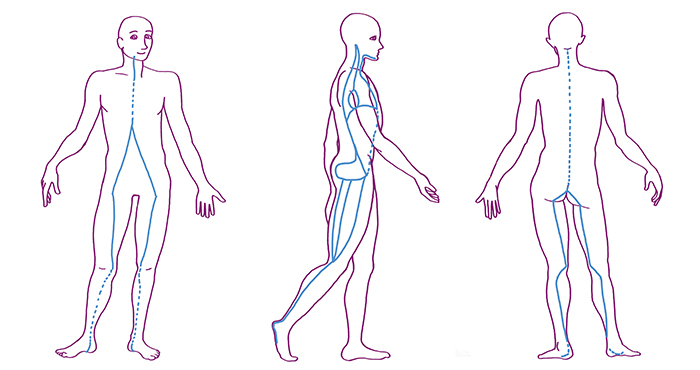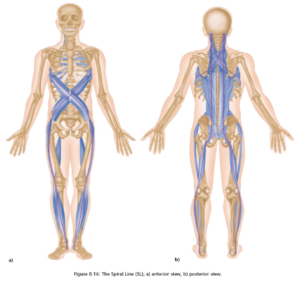The concept of Fascia Lines is a great way to understand how the body functions and how treatment can be optimized to increase mobility and functionality. The main principle is that muscles, no matter what they do individually, also affect tissues throughout the entire body.
Anatomy Trains by Tom Myers is an excellent book to read with many facts about both training, exercises for mobility and the Fascia’s construction. What it is perhaps best known for is the power transmission lines also known as myofascial lines.
The lines enclose muscles, and it is sometimes described what the function of these muscles is or what type of muscle fiber the line contains. The lines are, therefore, not stand alone, but enclose organs, muscles and other tissues and parts which are included in the line.
Fascia lines according to Tom Myers
The basic hypothesis of Thomas Myers’ writings on Fascia kinetic lines is that muscles, no matter what they do individually, also affect tissues throughout the entire body through Fascia-based interconnections.
These interconnections can be called Fascia lines and can be followed by the body’s dissectible “meridians” of connective tissue structures. They consist of membranes and ligaments, both superficial and deep connective tissue, loose and tight.
These Fascia lines create stability, resistance, power, flexibility, elasticity, and above all, compensatory postures. So connective tissue structures work in sync, creating a fluid and balanced movement and a posture that maintains balance and direct contact between all body parts.
The Deep Front Line

The deep front line is located between the right and left lateral lines in the front plane, wedged between the superficial front line and superficial dorsal line in the sagittal plane. It is surrounded by “spiral lines” and “functional lines”. Here’s a link to the dissection video.
The deep front line includes the body’s Myofascial “core”. If we start from the bottom the line has deep roots under the foot, passing up the skeleton of the back leg, behind the knee, and inner thigh. From here, a larger track runs through the hip, pelvis, and lumbar vertebrae front while an alternative pathway runs along the back of the thigh to the pelvic floor after which it returns with the first part at the lumbar vertebrae.
Further upward through the diaphragm the deep front line passes up through the chest with many branches through the thoracic viscera and ends on the bottom of both the neutral and the visceral cranium.
This line is the most three-dimensional in shape rather than a line. All lines are of course partly three-dimensional, but they are more like power transmission lines.
The deep front line definitely takes up more space than other lines. In the legs the deep front line envelops most of the stabilizing muscles. Through the hip the line has a close relation to the hip joint and synchronizes the rhythm of our walk with the rhythm of our breathing.
In the torso, the deep front line along with the autonomic ganglia runs between our neuromotor chassis and the organs that support cells in the ventral chest cavity.
In the neck, the deep frontal line provides a counterbalance to the pulling mechanisms that the superficial front and back line causes.
An in-depth understanding of this line is essential for successful treatment in almost all types of manual techniques and therapies.
The Spiral Line
Another kinetic chain of energy that crosses the front of the body is the “spiral line”. This website provides a great overview based on Tom Meyer’s theories and philosophy.
Tom Meyer’s book Anatomy Trains explains his theory in detail.
Yoga Therapy Ball classes will be offered later this year! Here’s a link to the therapy balls I’ll be using in my classes. You will need two balls and one pouch per person.


